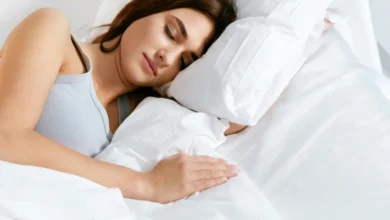The Role of Exercise in Regulating Sleep Hormones
Are you having trouble sleeping because of unbalanced hormones like melatonin and cortisol?
Regulating sleep hormones is key to getting better rest, and exercise can help.
At Healthy Stride Wellness, we believe that simple changes to your fitness routine can make a big difference in balancing these hormones.
In this blog, we’ll show you how exercise works to regulate sleep hormones, the best exercises to try, and how to create a routine that boosts both your sleep and recovery.
Keep reading to improve your sleep naturally.
Table of Contents
Key Takeaways
- Exercise boosts melatonin production, helping regulate your sleep-wake cycle.
- Physical activity reduces cortisol levels, lowering stress and promoting relaxation for better sleep.
- Regular exercise increases serotonin and dopamine, improving mood and making it easier to fall asleep naturally.
Understanding Sleep Hormones and Their Role in Recovery
Sleep hormones are chemical messengers that play a vital role in regulating the body’s sleep-wake cycle. The two most important sleep hormones are melatonin, which promotes sleep, and cortisol, which helps us wake up and stay alert throughout the day.
However, stress, irregular sleep patterns, and poor lifestyle choices can disrupt these hormones, leading to poor sleep quality and reduced recovery, especially for those engaging in regular physical activity.
What Are Sleep Hormones?
Melatonin, often referred to as the “sleep hormone,” is produced by the pineal gland in response to darkness. It helps regulate our internal clock (circadian rhythm) and signals to the body that it’s time to wind down and sleep.
On the other hand, cortisol, known as the “stress hormone,” follows a daily rhythm, peaking in the morning to help us wake up and gradually decreasing throughout the day.
When cortisol levels are too high—often due to stress—it can interfere with the production of melatonin, disrupting sleep. This is where exercise becomes an invaluable tool for regulating sleep hormones.
How Does Physical Activity Affect Sleep Hormone Levels?
Exercise has a profound impact on sleep hormone regulation. By reducing cortisol levels and boosting melatonin production, physical activity promotes deeper, more restful sleep.
Regular workouts help synchronize your circadian rhythm, improving your body’s ability to balance these hormones and regulate sleep naturally.
Effects of Regular Workouts on Sleep Quality and Hormones:
- Reduces cortisol, leading to lower stress levels and better sleep.
- Increases melatonin production, helping you fall asleep faster and stay asleep longer.
- Improves the overall balance of sleep and stress hormones.
How Exercise Regulates Sleep Hormones Naturally
Regular exercise is one of the most effective ways to naturally regulate sleep hormones. The key is understanding how different types of exercise can influence both melatonin and cortisol levels.
Exercise and Its Impact on Melatonin and Cortisol Levels
Physical activity triggers a chain reaction of hormonal responses in the body. It not only reduces cortisol levels post-workout but also enhances melatonin production later in the day, especially if exercise is done in the afternoon or early evening.
How Exercise Boosts Sleep Hormones:
- Melatonin: Exercising outdoors in natural light helps regulate your circadian rhythm and increase melatonin production in the evening.
- Cortisol: Intense exercise can raise cortisol levels temporarily, but over time, regular exercise helps lower baseline cortisol levels, making it easier to manage stress and sleep better.
- Body Temperature: Exercise aids in reducing your body temperature post-workout, mimicking the natural temperature drop that happens as you fall asleep. This reminds your body that it’s time to relax.
- Serotonin: Workouts, especially aerobic exercises, elevate serotonin levels, which play a role in stabilizing your mood and aiding melatonin production, thereby improving sleep regulation.
- Stress Reduction: Exercise is a proven stress reliever, which indirectly improves sleep by reducing cortisol, a hormone that can disturb sleep if levels are too high.
- Mood Enhancement: Engaging in physical activity improves mood by increasing endorphins and serotonin, helping to create a positive mental state that promotes better sleep.
- Slow-Wave Sleep (Deep Sleep): Consistent moderate exercise has been shown to increase slow-wave sleep, the deepest stage of sleep, which is critical for physical recovery and brain health.
- REM Sleep: Exercise may enhance REM sleep, the stage where dreaming occurs and emotional processing takes place, leading to a more balanced and restorative sleep cycle.
For individuals struggling with stress-induced sleep issues, incorporating exercise into their routine is a powerful strategy for regulating sleep hormones.
For example, research highlighted by the American Psychological Association found that individuals who engaged in 30 minutes of aerobic exercise experienced not only a 25% reduction in cortisol levels but also improved melatonin levels that evening, making it easier to fall asleep. You can read more on how exercise impacts sleep at APA.
Best Exercises for Improving Sleep Hormone Balance
When it comes to regulating sleep hormones, not all exercises are created equal. Certain types of workouts are more effective at balancing melatonin and cortisol levels than others.
Here are some of the best exercises that contribute to better sleep:
1. Moderate Aerobic Exercises
Exercises such as walking, jogging, swimming, or cycling can reduce cortisol and promote the release of endorphins, which help improve mood and reduce stress. These exercises, when performed regularly, can support the natural rise of melatonin in the evening.
2. Yoga and Stretching
Yoga, especially practices focused on deep breathing and relaxation, is incredibly effective for lowering cortisol levels. Yoga helps to calm the mind, reduce anxiety, and create the ideal environment for melatonin production. Incorporating yoga into your sleep recovery routine can significantly improve hormone balance.
3. Strength Training
Strength training, done in moderation, is another great way to boost melatonin production. It triggers muscle repair during sleep, which requires the body to enter deeper sleep stages. Just make sure not to perform intense strength training too close to bedtime, as this can temporarily raise cortisol levels.
Top Exercise Strategies to Improve Sleep Hormones Naturally:
- Include aerobic exercises 3-4 times per week to promote hormonal balance.
- Practice yoga or stretching before bed to reduce cortisol and prepare for sleep.
- Engage in moderate strength training to enhance deep sleep and recovery.
Creating a Routine for Optimal Sleep Hormone Regulation
To reap the full benefits of exercise for sleep, it’s essential to create a structured routine that aligns with your body’s natural rhythm.
Here’s how you can design an effective sleep recovery routine focused on regulating sleep hormones.
Routines for Enhancing Sleep Hormone Levels with Fitness
- Morning or Early Afternoon Workouts: Exercising early in the day helps reduce cortisol levels later in the evening. Aim for aerobic activities such as jogging, cycling, or swimming for at least 30 minutes.
- Pre-Bed Stretching and Yoga: Practicing yoga or gentle stretching an hour before bed helps lower stress and prepares the body for sleep. Focus on poses that promote relaxation, such as Child’s Pose, Forward Fold, and Legs Up the Wall.
- Strength Training: Incorporate moderate strength training 2-3 times per week. Avoid heavy workouts late in the evening, as this can raise cortisol levels temporarily and interfere with sleep.
- Consistency: Stick to a consistent routine. The body responds well to regular physical activity, helping it regulate sleep hormones effectively over time.
Practical Tips for Managing Sleep Hormones Through Exercise
While creating a routine is important, knowing how to manage sleep hormones through exercise on a day-to-day basis can further enhance your results.
Let’s talk about some handy tips you should remember:
Tips to Manage Sleep Hormones with Physical Activity
- Exercise Timing: Avoid intense exercise too close to bedtime, as this can raise cortisol levels and make it harder to fall asleep.
- Moderation: Overtraining can disrupt hormone levels. Balance intense workouts with gentle exercises like yoga or walking.
- Hydration and Nutrition: Staying hydrated and eating a balanced diet that supports hormone production is key to regulating sleep hormones through exercise.
Guidance on Sleep Hormone Regulation Through Workouts
The goal is to find the right balance between exercise intensity and recovery. Avoid extremes—both excessive exercise and inactivity can disrupt sleep hormones.
Start with moderate workouts and gradually adjust based on how your body responds.
Comparing Exercises and Their Effectiveness on Sleep Hormones
Different exercises have varying effects on regulating sleep hormones. Here’s a comparison of how different types of exercises impact melatonin and cortisol levels:
Aerobic vs. Strength Training vs. Yoga
- Aerobic Exercise: Great for lowering cortisol levels and boosting melatonin, especially when done in the morning or afternoon.
- Strength Training: Helps enhance deep sleep and muscle recovery, promoting melatonin production during the night.
- Yoga: The best for reducing stress and cortisol, particularly when done before bed.
By combining these exercises, you can create a balanced routine that supports hormone regulation and improves sleep quality.
Fitness Routines Designed for Optimal Sleep Hormone Regulation:
- Morning: 30 minutes of moderate aerobic activity (walking, cycling, or jogging).
- Evening: 15-20 minutes of gentle yoga or stretching to wind down.
- Strength Training: 2-3 times per week, earlier in the day, to avoid cortisol spikes at night.
Learn How to Regulate Sleep Hormones with Exercise
If you’re looking to enhance your sleep quality, it’s essential to understand the role exercise plays in regulating sleep hormones like melatonin and cortisol.
By incorporating regular physical activity into your daily routine, you can effectively balance these hormones, leading to better rest and overall recovery.
To learn how to regulate sleep hormones with exercise, start with moderate-intensity workouts during the day, such as walking, cycling, or strength training.
These activities help reduce cortisol levels and boost melatonin production, creating a natural environment for better sleep.
Additionally, focus on evening relaxation techniques like yoga or stretching. These exercises calm the mind, lower stress, and prepare your body for restful sleep by naturally influencing your sleep hormones.
By following a structured routine, you’ll be able to manage your sleep recovery and hormone regulation effectively.
Compare Exercises for Balancing Melatonin and Cortisol
When it comes to balancing melatonin and cortisol for optimal sleep, different types of exercises have varying effects. Here’s a quick comparison:
- Aerobic Exercises: Activities like walking, jogging, and swimming are highly effective in reducing cortisol levels and helping your body produce melatonin later in the day. These exercises are best done earlier in the day to optimize hormone regulation.
- Strength Training: Moderate strength training boosts melatonin production during sleep and supports muscle recovery, but it’s important to avoid heavy lifting too close to bedtime, as it can temporarily raise cortisol levels.
- Yoga and Stretching: These exercises excel at reducing cortisol levels and are ideal for balancing sleep hormones right before bed. Gentle yoga practices promote relaxation and prepare your body for deep sleep by increasing melatonin.
For example, a study referenced by the National Sleep Foundation showed that individuals who practiced yoga and stretching in the evening experienced a 27% decrease in cortisol levels and a boost in melatonin production, making it easier to fall asleep. Learn more about how specific exercises improve sleep hormone balance at the National Sleep Foundation.
By comparing these exercise types, it’s clear that incorporating a mix of aerobic workouts during the day and calming exercises in the evening is the most effective strategy for regulating sleep hormones and improving sleep quality.
Conclusion
Exercise plays a crucial role in regulating sleep hormones like melatonin and cortisol, both of which are essential for maintaining a healthy sleep cycle.
By incorporating specific types of exercise into your routine, you can naturally balance these hormones, improve sleep quality, and support overall recovery.
Whether through aerobic exercises, yoga, or strength training, creating a sleep recovery routine that focuses on hormonal balance is key to optimizing your rest and enhancing your physical well-being.
At Healthy Stride Wellness, we encourage you to start implementing these strategies today to experience the full benefits of regulating sleep hormones through exercise.
Unlock better rest with Healthy Stride Wellness!
Our expert tips on regulating sleep hormones can supercharge your sleep recovery for optimal health and fitness. Start your journey to better sleep today!
FAQs
Does exercise increase REM sleep?
Yes, regular exercise can improve the amount of REM sleep, enhancing memory, learning, and emotional processing.
What type of exercise is best for sleep?
Moderate aerobic exercises like walking, cycling, or swimming are best for promoting better sleep and regulating sleep hormones.
Does exercise produce melatonin?
Exercise doesn’t directly produce melatonin but can stimulate its production by helping regulate your circadian rhythm.
Do fit people need less sleep?
Fit people still need 7-9 hours of sleep for recovery, but they often experience better quality sleep due to physical activity.
How does exercise help in regulating sleep hormones?
Exercise helps lower cortisol and increase melatonin levels, making it effective for regulating sleep hormones and improving sleep quality.
Please Note: Healthy Stride Wellness provides educational content and is not a replacement for medical advice. Consult a healthcare provider for any health issues.





